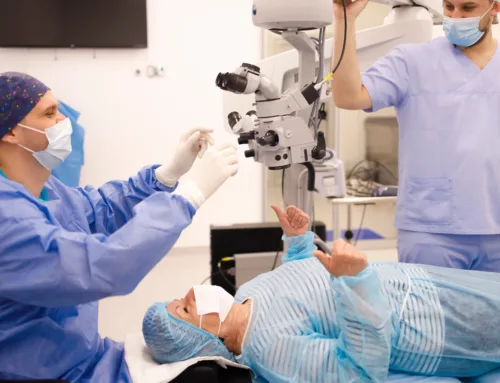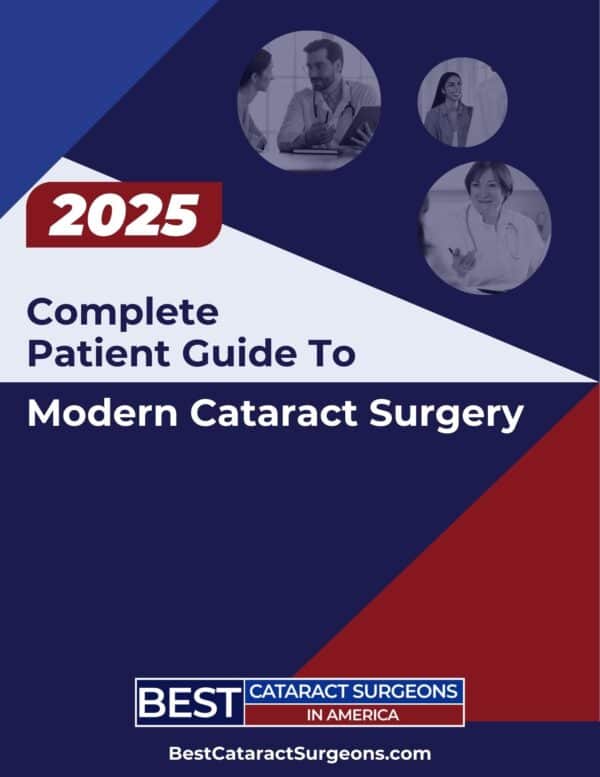The Tecnis Eyhance lens implant, by Johnson & Johnson Surgical Vision (JJSV), utilizes extended depth of focus (EDOF) technology to deliver similar distance vision and better intermediate vision compared to a standard monofocal lens.
The Eyhance IOL (intraocular lens implant) was approved as a monofocal intraocular lens by the Federal Drug Administration (FDA) in February 2021, and technically is not classified by the FDA as an EDOF lens because of the very specific criteria required for that designation, and clinical trial data that is required for a lens implant to have that designation by the FDA, however, it does provide patients with increased intermediate range vision compared to many other monofocal implants.
In this Complete Patient Guide to the Eyhance IOL, we’re going to cover everything you need to know about this enhanced monofocal implant.

How Does the Eyhance IOL Work?
The lens is made of the same platform as the Tecnis monofocal, but now with a slight, central steepening to give an extended depth of focus. This slight, gradual steepening translates into a smooth and continuous increase in power without rings, therefore decreasing the number of visual aberrations particularly at nighttime. Studies have shown that the Eyhance lens has better intermediate vision compared to the Tecnis monofocal, with minor impact on the distance vision quality. Two studies have also demonstrated a greater spectacle independence with the Eyhance lens.
Is There an Eyhance Toric IOL to Fix Astigmatism?
The Eyhance lens is available in the toric lens implant version to treat patients with higher levels of astigmatism. The toric version incorporates the latest haptic design by Johnson & Johnson to prevent toric rotation. Both the Eyhance and Eyhance toric lenses are injected into the eye using the Tecnis Simplicity delivery system, which is one of the easiest and fastest ways to inject the lens into the eye.
What is the Eyhance IOL Price?
Because the Eyhance is often used during cataract surgery in which astigmatism is managed, most patients should expect there to be an out-of-pocket expense for this implant. Whenever there is a goal to be free from glasses after cataract surgery, typically medical insurance does not fully cover these vision-correcting aspects of the procedure.
Commercial medical insurance and Medicare will still cover other parts of the surgery. However, they historically have only covered basic lens implants, in which astigmatism and presbyopia are not treated, resulting in most patients requiring glasses for their best vision.
The out-of-pocket Eyhance price is set by each individual practice, and can vary based on region, surgeon experience, and the other techniques and technology that is used, such as femtosecond laser assisted cataract surgery.

What Should Patients Expect from Eyhance Lenses?
One of the main benefits of modern cataract surgery is that it can help you achieve freedom from glasses. The Tecnis Eyhance lens may be the right choice for patients that want some degree of intermediate range vision, in addition to distance range vision, with the least possible visual aberrations (i.e. glare and halo symptoms) or decrease in contrast sensitivity.
The goal of the Eyhance lens implants is typically to be free from glasses for distance activities, such as driving and outdoors activities, and intermediate range activities, such as using a computer or viewing the dashboard in the car. In this way it is similar to the Vivity lens implant. Other lens implants, such as the Synergy lens implant, may provide better near vision, by may result in more glare and halo symptoms.
The Eyhance lens is intended to decrease the need for spectacles, however, patients should be prepared to wear reading glasses if needed for near work, like reading the newspaper.











